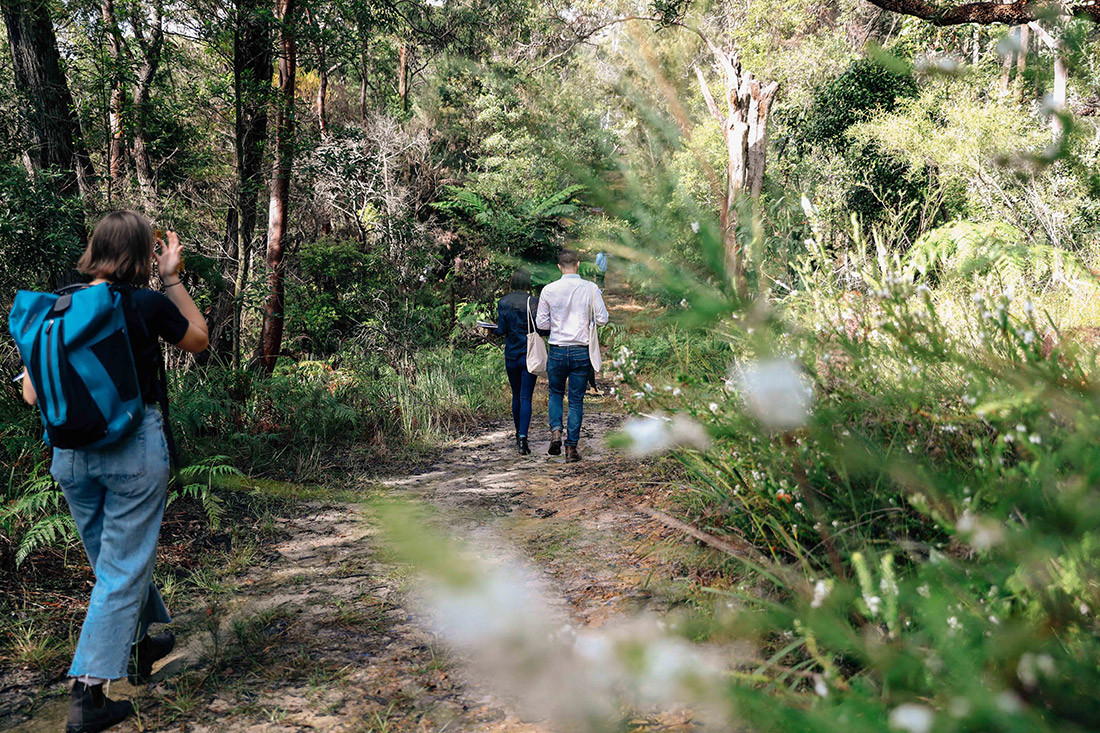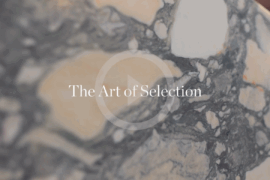Forget about human-centred design; a new report published by Arcadia Landscape Architecture says a shift to Country-centred design is what Australia needs.

It’s evident that, throughout the architecture and design industry—and even more broadly, the built environment fields—the vast majority of us genuinely want to do the right thing by First Nations people, as well as Country. The challenge, however, is knowing where and how to begin cultural engagement in a way that goes deeper than what leading historian Mark McKenna dubs the “ornamental recognition of Indigenous Australians”, and instead starts to create meaningful change.

Arcadia suggests ‘walkshops’ on Country with local Knowledge Holders
Our hats go off to Arcadia Landscape Architecture for releasing a truly groundbreaking report, bequeathing answers to the questions so many of us have been wondering in simultaneous silence. Questions like… How can I integrate connection to Country into my work, without it being another buzzword or just a box-ticking exercise?
Produced in collaboration with Dr Danièle Hromek, a spatial designer, researcher, and Budawang woman of the Yuin nation, along with Arcadia’s own Kaylie Salvatori, a landscape architect and proud Yuin woman, the report is titled: Shaping Country: Cultural engagement in Australia’s built environment.

“In the last 12 months, we’ve been approached by clients and others seeking guidance and advice on how to go about engaging First Nations peoples in their projects,” says Arcadia’s founder, Alex Longley. Arcadia’s own journey of consciously honing its approach to First Nations engagement and connection to Country as a practice began about 5 years ago, well before it became the latest buzzword.
Even prior to that, acknowledgement of Indigenous narratives and consideration of Country have always been core elements of the firm’s projects. in fact, it’s the first thing the team looks into when embarking on a new project. Susan Wakil Health Building and St Leonards Health Organisation Relocation (SHOR) are two examples from Arcadia’s body of recent work that serve as exemplary case studies of First Nations engagement in practice and the unique value it brings to the design perspective.

Meaningful First Nations engagement is about ‘collaboration, not consultation’ the report stresses
“We were once tasked with designing a new landscape area for a school. There was a Casuarina tree on-site that was earmarked for removal, to accommodate the built form. But during a walkshop on Country with a local Elder, he shared with us that Casuarina trees have been purposefully planted in play areas throughout Indigenous communities for centuries as a tool to protect children from snakes,” says Michael Barnett, Arcadia’s director, in an anecdote quoted in the report. “…the Casuarina became a focal point of the design from there on out.”
Suffice it to say that the Sydney-based landscape architecture practice is well poised to offer advice on the best etiquette for cultural engagement – and it’s getting noticed.

Situated on Gadigal land, the grounds surrounding Susan Wakil Health Building at University of Sydney cultivate an interpretation of the cycle of healing. Photo: Brett Boardman
Shaping Country: Cultural engagement in Australia’s built environment is the result of a passion project Arcadia began earlier this year led by Indigenous landscape strategist, Kaylie Salvatori, and Dr Danièle Hromek. The project heeds the industry’s silent yet resounding call for guidance in achieving more meaningful First Nations engagement – but to Salvatori and Hromek, the opportunity to raise the bar of First Nations awareness in Australia’s built environment was of personal significance.
The report itself is a prudently articulated culmination of pertinent insights and learnings Arcadia has derived through its extensive experience with cultural engagement in practice. Its contents address everything from the ‘right’ language and etiquette; how to engage with Knowledge Holders and common challenges that are encountered; steps for engaging with country (complete with case study); through to how meaningful First Nations engagement leads to ‘Better Placed’ design, and the impacts on commercial outcomes. On top of all that, it also presents advice on what to do when cultural engagement is not possible, actionable next steps and suggestions for further reading.

Arcadia’s approach is for a design outcome which subtly communicates the history of the site so that occupants have the opportunity to reflect while using the space.
“More than anything, I hope [Shaping Country] fast-tracks awareness amongst the industry,” says Longley. “It would be great to see us reach a base level of shared understanding across the built environment sector – only from there will we be able to move forward.”
“If we are truly going to start designing for this place, we need to start including the longer narratives of this place – the narratives that go back to before time can be measured – in the design of the place,” says Dr Hromek. “To me, this means ensuring Country is lead architect and First Peoples are narrators and interpreters for all projects – not just those with perceived Indigenous values or relevance.”
Well, what are you waiting for? Have a read of Shaping Country: Cultural engagement in Australia’s built environment now. We’d love to hear your thoughts.
INDESIGN is on instagram
Follow @indesignlive
A searchable and comprehensive guide for specifying leading products and their suppliers
Keep up to date with the latest and greatest from our industry BFF's!

For a closer look behind the creative process, watch this video interview with Sebastian Nash, where he explores the making of King Living’s textile range – from fibre choices to design intent.

For those who appreciate form as much as function, Gaggenau’s latest induction innovation delivers sculpted precision and effortless flexibility, disappearing seamlessly into the surface when not in use.

Merging two hotel identities in one landmark development, Hotel Indigo and Holiday Inn Little Collins capture the spirit of Melbourne through Buchan’s narrative-driven design – elevated by GROHE’s signature craftsmanship.

Australia’s first planted light rail corridor sets new benchmark for transport-led urban transformation.

Community, Country and climate were centred at the 2025 Australian Institute of Landscape Architects (AILA) Awards in Lutruwita/Tasmania on 21st October.
The internet never sleeps! Here's the stuff you might have missed

CDK Stone’s Natasha Stengos takes us through its Alexandria Selection Centre, where stone choice becomes a sensory experience – from curated spaces, crafted details and a colour-organised selection floor.

Former INDE Luminary LeAmon joins the Design Institute of Australia (DIA) following more than a decade as the inaugural Curator of Contemporary Design and Architecture at the National Gallery of Victoria (NGV).